FAQ About Trees
Frequently asked questions (FAQs) about trees and plants as a whole. Each FAQ is answered by a student of Dr. Sara Wright’s Plant Diversity course. Each student also researched a tree species that you can learn about on the Trees page or by clicking the link of the students’ names!
Why are plants green?
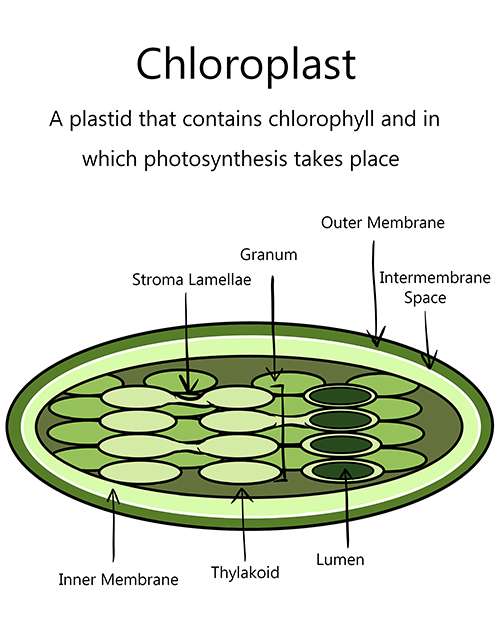 Plants consist of chlorophyll. This is a pigment that gives plants their green color and also assists plants in the process of photosynthesis by absorbing sunlight and powering the process of producing their own food. Chlorophyll absorbs red light the most efficiently and presents its complementary, unused color of green wavelength to our eyes. The pigment is located in the chloroplasts within cells of plant leaves – chloroplasts are like specialized organs inside plant cells. Absorbed light energy powers photosynthesis, which is used to convert carbon dioxide and water into glucose and releases oxygen as a by-product.
Plants consist of chlorophyll. This is a pigment that gives plants their green color and also assists plants in the process of photosynthesis by absorbing sunlight and powering the process of producing their own food. Chlorophyll absorbs red light the most efficiently and presents its complementary, unused color of green wavelength to our eyes. The pigment is located in the chloroplasts within cells of plant leaves – chloroplasts are like specialized organs inside plant cells. Absorbed light energy powers photosynthesis, which is used to convert carbon dioxide and water into glucose and releases oxygen as a by-product.
Researched by Israt Jashim, Biological Sciences (2024) and Computing & Informatics (2024)
Please use this link to visit Israt’s tree, the Atlas Cedar.
Learn more about what plants are green:
What keeps a plant standing upright?
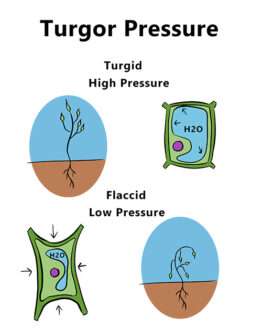 Turgor pressure within the cells of the stem keeps the plant upright. Turgor pressure is caused by water, from osmosis, filling the large storage organelles (vacuoles) inside of plant cells. This causes the liquid inside the cells to exert pressure on the outer cell walls, thus making the cells resemble sturdy brick walls as a group. Cellulose and lignin are molecules that aid in the structural support of the plant by providing rigidity to the cell walls and stems, ultimately enabling plants to grow larger on land. Lastly, roots can help keep the plant upright. The roots anchor the plant into the ground which helps keep it standing during strong winds and herbivory attacks.
Turgor pressure within the cells of the stem keeps the plant upright. Turgor pressure is caused by water, from osmosis, filling the large storage organelles (vacuoles) inside of plant cells. This causes the liquid inside the cells to exert pressure on the outer cell walls, thus making the cells resemble sturdy brick walls as a group. Cellulose and lignin are molecules that aid in the structural support of the plant by providing rigidity to the cell walls and stems, ultimately enabling plants to grow larger on land. Lastly, roots can help keep the plant upright. The roots anchor the plant into the ground which helps keep it standing during strong winds and herbivory attacks.
Researched by Ashton Paladino, Biological Sciences (2024)
Please visit this link to visit Ashton’s tree, the Douglas Fir
What is wood?
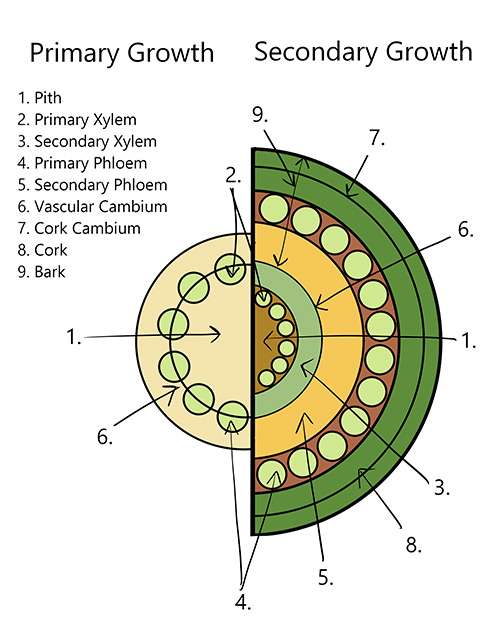 Wood is a tissue in certain types of plants that gives structural support. This tissue is porous and fibrous. It is a composite of cellulose, which is strong in tension, and a matrix of lignin, which resists compression. Plants grow in two different ways, vertically and laterally, also called primary and secondary growth. Wood is produced through lateral growth, in order to support the great heights achieved by primary growth. Lateral growth is the widening of the stem or trunk. Between outer bark and inner wood, there is cambium, which is a layer of undifferentiated cells. The cells in the cambium divide, which pushes the bark outward and the older wood inwards, creating this lateral growth. This is also why we see rings in trees. The rings indicate growth during the different seasons. Wood can be classified as either hardwood and softwood. The names do not always mean that one group has wood that is harder or softer than the others, it refers more to the structure of the wood and how easily trees were cut down during times of European expansion. Hardwood usually comes from flowering trees (angiosperms) and is more complex and variable in structure. Softwood usually comes from non-flowering trees (gymnosperms), like conifers.
Wood is a tissue in certain types of plants that gives structural support. This tissue is porous and fibrous. It is a composite of cellulose, which is strong in tension, and a matrix of lignin, which resists compression. Plants grow in two different ways, vertically and laterally, also called primary and secondary growth. Wood is produced through lateral growth, in order to support the great heights achieved by primary growth. Lateral growth is the widening of the stem or trunk. Between outer bark and inner wood, there is cambium, which is a layer of undifferentiated cells. The cells in the cambium divide, which pushes the bark outward and the older wood inwards, creating this lateral growth. This is also why we see rings in trees. The rings indicate growth during the different seasons. Wood can be classified as either hardwood and softwood. The names do not always mean that one group has wood that is harder or softer than the others, it refers more to the structure of the wood and how easily trees were cut down during times of European expansion. Hardwood usually comes from flowering trees (angiosperms) and is more complex and variable in structure. Softwood usually comes from non-flowering trees (gymnosperms), like conifers.
Researched by Emily Setaro, Biological Sciences (2023) and Education (2024)
Please use this link to visit Emily’s tree, the Loblolly Pine
Learn More about Wood:
Everyone knows wood is good, but what is wood exactly?
How do plant roots soak up water?
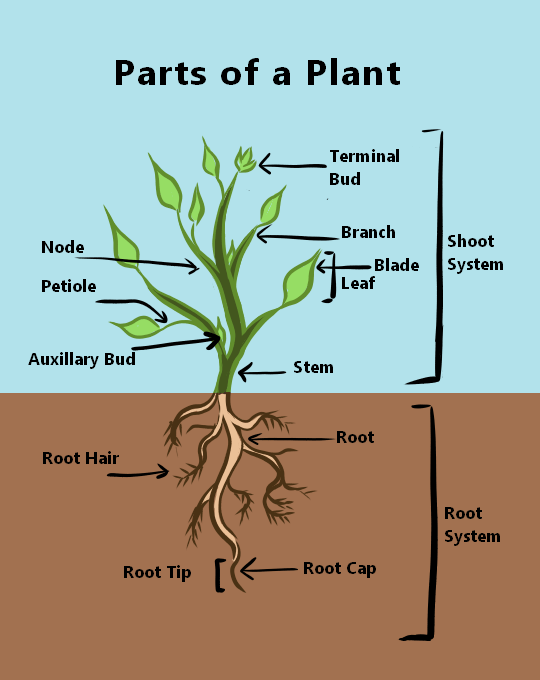 When considering how plants soak up water, it is important to understand the structure of the roots. Two important parts of the plant root in terms of water movement are its vascular system and root hairs. The vascular system helps transport water and nutrients up from the soil to the tip of the plants and back down to the soil. The main components of this vascular system are the xylem and phloem. The xylem is predominantly water transport, while the phloem is predominantly mineral transport. Xylem has an ionic charge, while water has a polar charge. This allows the water to move upwards since the charge from the xylem can attach to the polar charges of the water and propel it upwards to hydrate the extremities of the plant. The root hairs are what take in the water, move the water to ground tissue, and transport the water to the xylem, where the xylem can bring water up the vascular system to the rest of the plant.
When considering how plants soak up water, it is important to understand the structure of the roots. Two important parts of the plant root in terms of water movement are its vascular system and root hairs. The vascular system helps transport water and nutrients up from the soil to the tip of the plants and back down to the soil. The main components of this vascular system are the xylem and phloem. The xylem is predominantly water transport, while the phloem is predominantly mineral transport. Xylem has an ionic charge, while water has a polar charge. This allows the water to move upwards since the charge from the xylem can attach to the polar charges of the water and propel it upwards to hydrate the extremities of the plant. The root hairs are what take in the water, move the water to ground tissue, and transport the water to the xylem, where the xylem can bring water up the vascular system to the rest of the plant.
Another strong factor in the movement of water through plant roots is considering its osmotic properties. Osmosis is the transport of water through a semipermeable membrane. The roots have a lower solute potential than the soil, so the water will move from soil to root passively. As the water moves from soil to root, the osmotic pressure of the xylem increases as well, which causes the interaction between the charges of the xylem and the water to increase, thus further propelling the water up the root.
Researched by Harley Rosenzweig, Biological Sciences (2023)
Please visit this link to visit Harley’s tree, the Mockernut Hickory
How does water flight gravity to move upward through a plant?
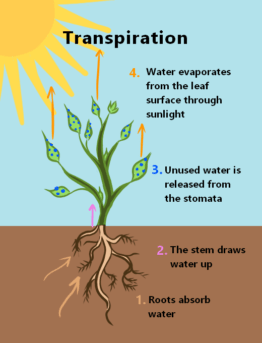 When trying to understand how water moves upwards through a plant, it is first important to understand the characteristics of a water molecule. Water molecules are polar. This means that each water molecule contains two partially positively charged hydrogen atoms on one side and one partially negatively charged oxygen atom on the other. Since water is polar, it is attracted to itself, called hydrogen bonding and/or cohesion. Water does not just stick to itself though. Water’s polarity allows it to stick to other things too. This is called adhesion. These characteristics are very important in how water can travel upwards through a plant.
When trying to understand how water moves upwards through a plant, it is first important to understand the characteristics of a water molecule. Water molecules are polar. This means that each water molecule contains two partially positively charged hydrogen atoms on one side and one partially negatively charged oxygen atom on the other. Since water is polar, it is attracted to itself, called hydrogen bonding and/or cohesion. Water does not just stick to itself though. Water’s polarity allows it to stick to other things too. This is called adhesion. These characteristics are very important in how water can travel upwards through a plant.
Water first enters a plant through its roots. The water continues to move up through the plant in the xylem. The water molecules stick together and also stick to the thick, lignin-containing walls of the xylem. As the water moves up the plant, it reaches the leaves. Water is released on the underside of the leaves through small pores called stomata. As a water molecule is released through the stomatal openings, it pulls other water molecules along behind it, due to cohesion. This entire process is called transpiration. Transpiration is constantly happening in plants all around us!
Researched by Valerie Vischoric, Biological Sciences (2023)
Please use this link to visit Valerie’s tree, the Willow Oak
How does a plant transport water and sugar through its body?
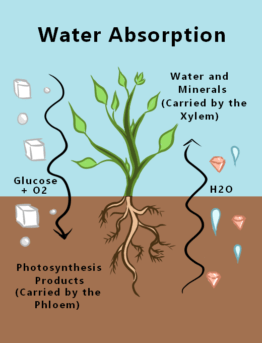
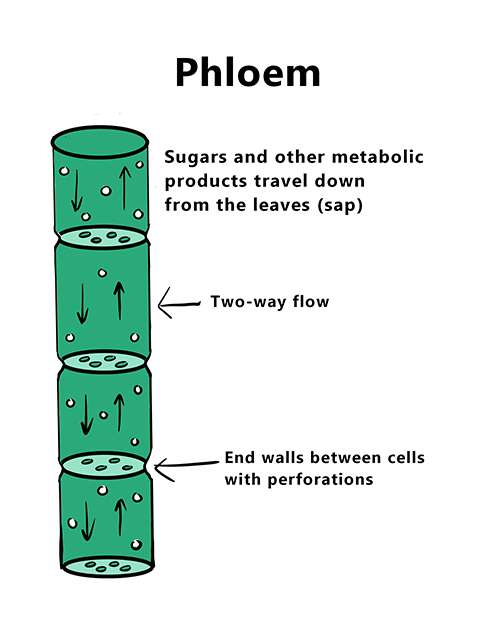
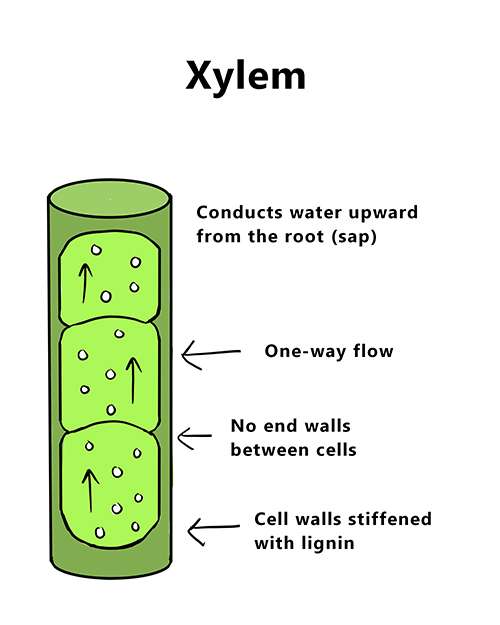 Plants contain two types of vascular tissue called xylem and phloem. These are sort of like our veins because they transport liquids through the body of a plant like our blood is transported through our veins. The xylem is made up of cells called tracheids and vessel elements. Both structures are elongated and narrow, and they’re also mostly dead tissues. The xylem’s primary function is to transport water. Water enters the plant’s roots by osmosis, then travels upwards through the xylem via capillary action. There is only one way for the water to move, and that is from the roots to the leaves.
Plants contain two types of vascular tissue called xylem and phloem. These are sort of like our veins because they transport liquids through the body of a plant like our blood is transported through our veins. The xylem is made up of cells called tracheids and vessel elements. Both structures are elongated and narrow, and they’re also mostly dead tissues. The xylem’s primary function is to transport water. Water enters the plant’s roots by osmosis, then travels upwards through the xylem via capillary action. There is only one way for the water to move, and that is from the roots to the leaves.
Phloem is composed of three different cell types: sieve, parenchyma, and sclerenchyma. This tissue is living, and these cells aid in transporting sugar carbohydrates from source to sink. The source is the active area of growth, such as leaves. The sink is the area of storage, such as the roots. Unlike xylem, phloem has the ability to move sap in two directions.
Researched by Neha Jacob, Biological Sciences (2023)
Are fungi good or bad for plants?
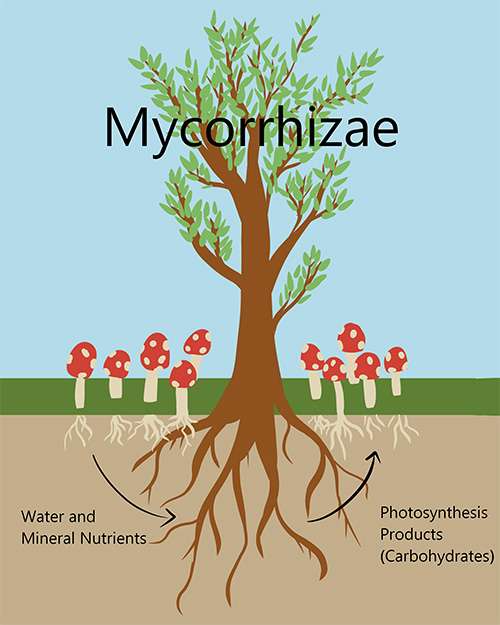 There are a lot of good things that fungi can do for plants, but there are also a lot of bad things fungi can do for plants as well. Through mycorrhizal fungi, plants can experience a mutualistic relationship with the fungi, where each species provides a benefit to the other. Ectomycorrhizal fungi attach their root-like structures called mycelium to the outside of the root system of a plant. This type of mycorrhizal fungi does not penetrate deep into the host tissue, and the interactions between the fungi and the host plant remain mostly on the surface where they can exchange nutrients. Endomycorrhizal fungi, however, are capable of penetrating into the root cells of the host plant, and while they can also form mutualistic relationships with plants they can also be harmful in some cases, due in part to the direct connection with the plants.
There are a lot of good things that fungi can do for plants, but there are also a lot of bad things fungi can do for plants as well. Through mycorrhizal fungi, plants can experience a mutualistic relationship with the fungi, where each species provides a benefit to the other. Ectomycorrhizal fungi attach their root-like structures called mycelium to the outside of the root system of a plant. This type of mycorrhizal fungi does not penetrate deep into the host tissue, and the interactions between the fungi and the host plant remain mostly on the surface where they can exchange nutrients. Endomycorrhizal fungi, however, are capable of penetrating into the root cells of the host plant, and while they can also form mutualistic relationships with plants they can also be harmful in some cases, due in part to the direct connection with the plants.
Some fungi are toxic to plant hosts, forming a parasitic relationship with the plant where they infect tissue and steal nutrients. This means the fungi will have a negative effect on the plant’s health and reproduction. Many fungal pathogens are extremely dangerous to plants and can actually disrupt whole harvests of a particular crop, which can have negative effects on humans, as well.
Researched by Luke Castagna, Biological Sciences (2023)
Please use this link to visit Luke’s tree, the Southern Red Oak
Why do some flowers smell good, but others smell bad?
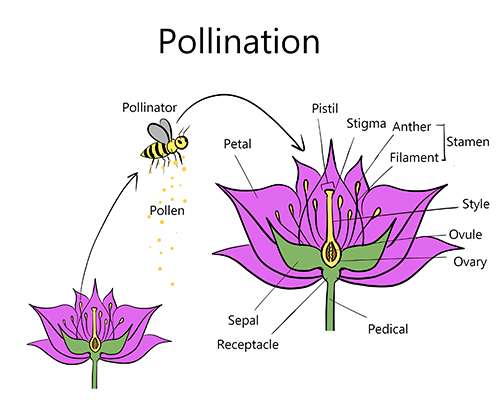
For flowering trees and plants, having a floral scent plays an important role in their reproductive processes. This is their way of attracting pollinators, and the volatiles emitted from the flowers tend to provide either insect or animal pollinators with information about the location and identity of the flower. This way, the plant can undergo pollination by the correct pollinators, which affects its fitness positively as the plant itself has to use less energy to undergo these processes. In this exchange of pollen grains from one plant to another, the insect also benefits, since they receive resources such as nectar, pollen and oils from the plant which either directly or indirectly enhance the pollinator’s fitness.
Flowers can have a variety of scents, and not all flowers smell good to humans. Flowers that have a bad odor to them (like feces or rotting material) attract pollinators like flies and beetles. Musty flowers attract moths. Sweeter smelling flowers attract bees and butterflies.
Researched by Dhara Patel, Biological Sciences (2023)
Please use this link to visit Dhara’s tree, the False Cypress.
What types of hormones do plants produce, and how do they use them?
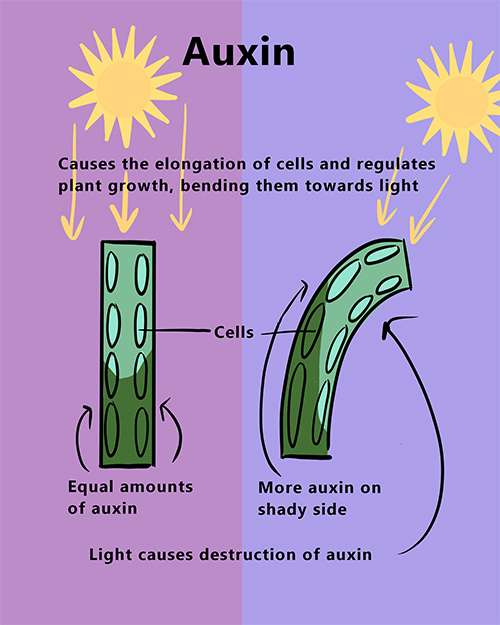 Similarly to humans, plants also produce hormones, which are chemical messengers that coordinate specific plant cell functions. Therefore, not all hormones are being produced at once, instead, it depends on the plant’s development and also the tissue that is being considered. Plants generally produce 9 major types of hormones: Auxins, Gibberellins (GAs), Abscisic Acid (ABA), Ethylene, Cytokinins (CKs), Salicylic Acid, Brassinosteroids (BRs), Strigolactones (SLs), and Jasmonic Acid (JA). Each one has its own function as listed below.
Similarly to humans, plants also produce hormones, which are chemical messengers that coordinate specific plant cell functions. Therefore, not all hormones are being produced at once, instead, it depends on the plant’s development and also the tissue that is being considered. Plants generally produce 9 major types of hormones: Auxins, Gibberellins (GAs), Abscisic Acid (ABA), Ethylene, Cytokinins (CKs), Salicylic Acid, Brassinosteroids (BRs), Strigolactones (SLs), and Jasmonic Acid (JA). Each one has its own function as listed below.
- Auxins are considered the master growth regulators. Some of the effects on the plant include bending towards the light source (phototropism), apical dominance growth pattern, downward root growth in response to gravity (gravitropism), beginning flower formation, aiding fruit growth, and inhibiting the falling of leaves (abscission).
- Gibberellins is an umbrella term for ~125 closely related hormones that are created in the apical meristems, young seeds, and embryos. They generally control stem, fruit, and seed growth so they have effects such as shoot elongation, seed germination, breaking seed dormancy, stimulating cell division, and fruit maturation.
- In opposition to the GAs, abscisic acid (ABA) is a general plant growth inhibitor/dormancy hormone in response to environmental stressors like drought and cold temperatures. ABA has been found to inhibit stem elongation, encourage abscission, close the stomata in drought conditions, and induce dormancy in later buds and seeds in unfavorable conditions.
- The aging hormone ethylene is found only in a gaseous volatile form which means it can be used in agriculture to our advantage. It is responsible for inducing fruit ripening and flower wilting, as well as causing leaf drooping (epinasty) and abscission. Farmers and horticulturists will control the ethylene levels in a greenhouse to control the timing of fruit ripening and life drooping.
- Cytokinins may sound familiar, and that is because these hormones are present in humans, as well as plants. Cytokinins stimulate cell division (cytokinesis) in the process of auxins.
- Salicylic acid is a hormone focused on the defense against pathogenic microorganisms such as viruses, bacteria, and fungi.
- Brassinosteroids, which is a group including 60+ steroid compounds, have a broad range of developmental effects like increasing the rate of cell division, stem and root elongation, and vascular differentiation.
- Strigolactones are signaling molecules that stimulate the growth of symbiotic mycorrhizal fungi in the soil microbiome. They also stimulate seed germination in parasitic plants when in close proximity to a suitable host plant.
- Lastly, jasmonic acid is an anti-herbivory hormone that is released when a systemin hormone responds to herbivorous wounds. Jasmonic acid tastes bad and prevents the breakdown of proteins in a herbivore’s gut. Both of these effects deter future herbivory
Researched by Ally Reagle, Biological Sciences (2023)
Please use this link to visit Ally’s tree, the Star Magnolia
If plants don't eat, how do they grow?
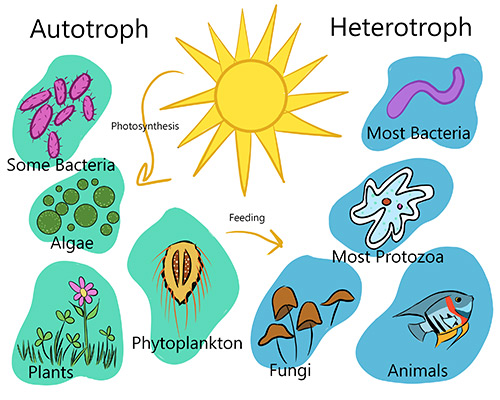 Plants are autotrophs, meaning they are self-nourishing/ feeding and can make their own food. The process of photosynthesis is what allows sunlight to be converted into energy. Carbon dioxide from the atmosphere is taken in through the stomata on the leaves and stems. Water enters the roots and travels through xylem in the trunk to the leaves. Chlorophyll, the pigment that gives plants their green color, traps the energy that the leaf collects, and the energy is used to break down water into hydrogen and oxygen. Through a series of reactions, the plant’s machinery fixes the atmospheric carbon dioxide in the form of sugar glucose. Glucose can then be used in respiration and to make other larger sugar polymers, like starches for energy and cellulose for rigid structure.
Plants are autotrophs, meaning they are self-nourishing/ feeding and can make their own food. The process of photosynthesis is what allows sunlight to be converted into energy. Carbon dioxide from the atmosphere is taken in through the stomata on the leaves and stems. Water enters the roots and travels through xylem in the trunk to the leaves. Chlorophyll, the pigment that gives plants their green color, traps the energy that the leaf collects, and the energy is used to break down water into hydrogen and oxygen. Through a series of reactions, the plant’s machinery fixes the atmospheric carbon dioxide in the form of sugar glucose. Glucose can then be used in respiration and to make other larger sugar polymers, like starches for energy and cellulose for rigid structure.
Researched by Rachel Ray, Biological Sciences (2022)
Please use this link to visit Rachel’s tree, the Black Cherry
What are cellulose and lignin, and why do they matter?
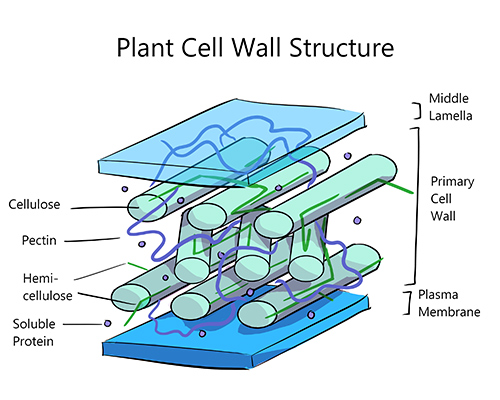 Cellulose and lignin are organic polymers that are important for providing plants with structure (since plants don’t have bones!). These compounds are both made primarily of carbon. Lignin is composed of linked phenols—carbon compounds with alcohol molecules (OH) called hydroxyl groups attached. Cellulose is made up of thousands of glucose molecules.
Cellulose and lignin are organic polymers that are important for providing plants with structure (since plants don’t have bones!). These compounds are both made primarily of carbon. Lignin is composed of linked phenols—carbon compounds with alcohol molecules (OH) called hydroxyl groups attached. Cellulose is made up of thousands of glucose molecules.
Cellulose is located in plant cell walls in order to make plant cells more rigid. Cellulose is purely a support structure, meaning that the plant will never get back the energy invested in creating it—its job is quite literally to just help the plant stand upright! Because all plants have it in their cells, cellulose makes up the greatest percentage of the Earth’s organic carbon. Additionally, cellulose can only be broken down by certain organisms that have an enzyme called cellulase, and very few organisms have the necessary enzyme. Some mammals such as cows and sheep have bacteria containing cellulase living in their stomach which allows them to digest the cellulose in the plants they eat.
Lignin is also found in plant cell walls for support, but more importantly, lignin is found in xylem. Xylem is a vessel through which plants bring water from their roots to their leaves and other structures in a process called transpiration. Transpiration relies on water’s ability to “stick” to the xylem. During transpiration, water molecules climb up the xylem to other areas of the plant from the roots. Furthermore, xylem is composed of dead cells that do not utilize the water moving through it, and lignin serves as waterproofing.
Researched by Fatima Hakimi, Biological Sciences (2023)
Please use this link to visit Fatima’s tree, the Purple Leaf Plum
How is photosynthesis related to climate change?
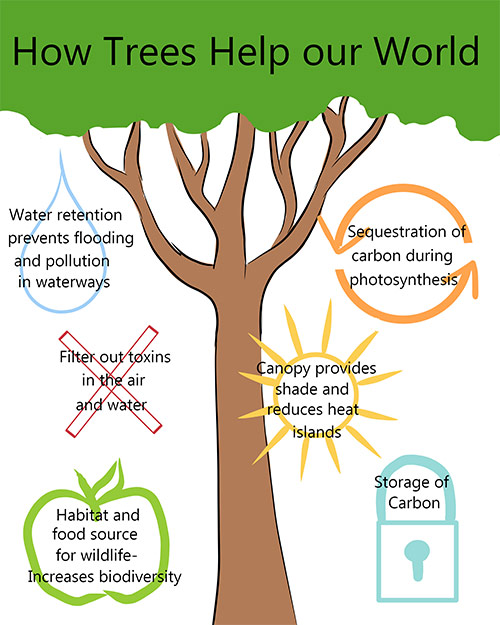 Photosynthesis is related to climate change because the process removes carbon dioxide from the atmosphere. At high temperatures, and when water is scarce, this is particularly important for C3 plants. Photosynthesis is also impacted by rising temperatures, although plants are very adaptable to their growing environments and can continue to operate even in extremely hot climates as long as there is enough water available. Carbon dioxide is used as a reactant during the photosynthesis process, which removes Carbon dioxide from the atmosphere. Global warming can be mitigated by reducing atmospheric carbon dioxide. Because they serve as a carbon sink, forests are essential for preventing climate change because they absorb carbon dioxide that would otherwise be released into the atmosphere and contribute to a continuing shift in weather patterns.
Photosynthesis is related to climate change because the process removes carbon dioxide from the atmosphere. At high temperatures, and when water is scarce, this is particularly important for C3 plants. Photosynthesis is also impacted by rising temperatures, although plants are very adaptable to their growing environments and can continue to operate even in extremely hot climates as long as there is enough water available. Carbon dioxide is used as a reactant during the photosynthesis process, which removes Carbon dioxide from the atmosphere. Global warming can be mitigated by reducing atmospheric carbon dioxide. Because they serve as a carbon sink, forests are essential for preventing climate change because they absorb carbon dioxide that would otherwise be released into the atmosphere and contribute to a continuing shift in weather patterns.
Researched by Sophia Paredes, Biological Sciences (2022)
Please use this link to visit Sophia’s tree, the White Mulberry
Why are forests sometimes called "carbon sinks"?
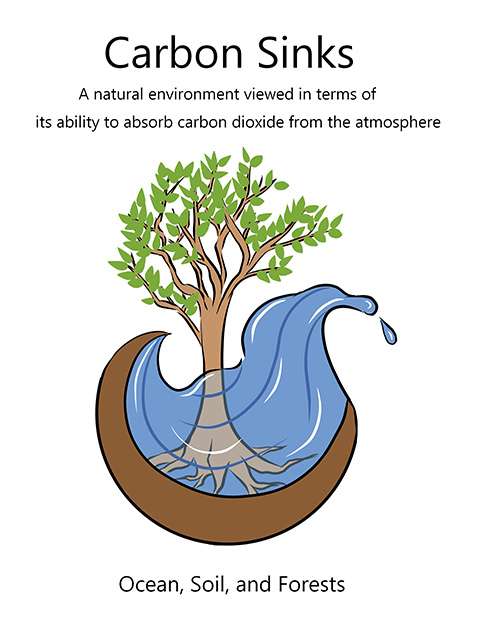 Forests are called “carbon sinks” because they take excess carbon from the atmosphere and absorb it. Carbon sinks take in more carbon than they release. In regards to the term, it references sinks and sources, The sink absorbs carbon dioxide from the atmosphere, whereas the carbon source releases carbon dioxide into the atmosphere. Regarding what deems a Carbon sinks, it’s when Photosynthesis (which takes in carbon dioxide) happens more than respiration and decomposition (which release carbon dioxide). Thus, the net result is that carbon is being removed from the atmosphere. Forest ecosystems are heavily crucial in carbon absorption because as carbon increases on the planet by means of human influence, forests have helped to absorb carbon emissions, which has aided with moderating climate change. In fact, one-fourth of all carbon emission by humans is absorbed by trees in forests. All in all, these carbon sinks are heavily influential and necessary for Earth’s survival and further emphasize the importance of forest preservation.
Forests are called “carbon sinks” because they take excess carbon from the atmosphere and absorb it. Carbon sinks take in more carbon than they release. In regards to the term, it references sinks and sources, The sink absorbs carbon dioxide from the atmosphere, whereas the carbon source releases carbon dioxide into the atmosphere. Regarding what deems a Carbon sinks, it’s when Photosynthesis (which takes in carbon dioxide) happens more than respiration and decomposition (which release carbon dioxide). Thus, the net result is that carbon is being removed from the atmosphere. Forest ecosystems are heavily crucial in carbon absorption because as carbon increases on the planet by means of human influence, forests have helped to absorb carbon emissions, which has aided with moderating climate change. In fact, one-fourth of all carbon emission by humans is absorbed by trees in forests. All in all, these carbon sinks are heavily influential and necessary for Earth’s survival and further emphasize the importance of forest preservation.
Researched by Tony Resendiz, Biological Sciences (2022)
Please use this link to visit Tony’s tree, the Black Tupelo
How do plants help purify the air we breath?
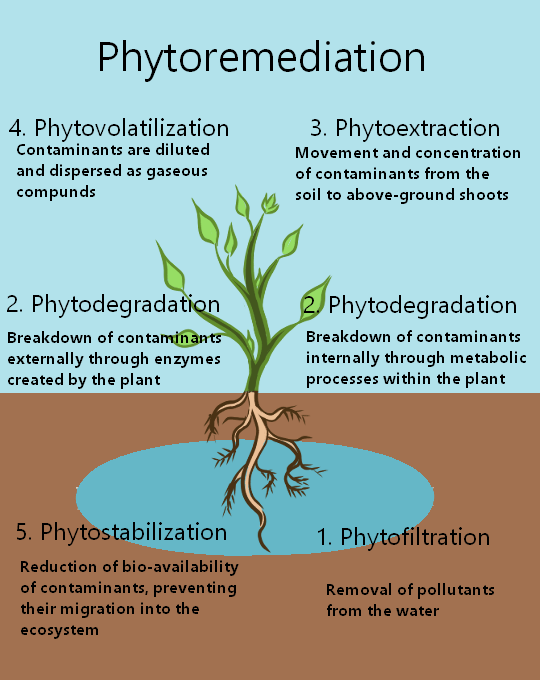 Plants can purify the air we breathe in two different ways. One of which is photosynthesis. Through photosynthesis, plants take carbon dioxide from the atmosphere through the stomata, and through absorption and filtering produce and release oxygen back into the atmosphere. The second way is through a process called phytoremediation which helps aid in pollution clean-up by using plants. Some plants have the potential to remove dangerous chemicals from the ground. It works by plants storing the chemicals in their roots and changing them into less effective and dangerous chemicals. It is effective, low costing, and all-natural, however, it does take a bit of time.
Plants can purify the air we breathe in two different ways. One of which is photosynthesis. Through photosynthesis, plants take carbon dioxide from the atmosphere through the stomata, and through absorption and filtering produce and release oxygen back into the atmosphere. The second way is through a process called phytoremediation which helps aid in pollution clean-up by using plants. Some plants have the potential to remove dangerous chemicals from the ground. It works by plants storing the chemicals in their roots and changing them into less effective and dangerous chemicals. It is effective, low costing, and all-natural, however, it does take a bit of time.
Researched by Reilly Dillon, Biological Sciences (2022)
Please use this link to visit Reilly’s tree, the Eastern Redbud
How do plants heal their wounds?
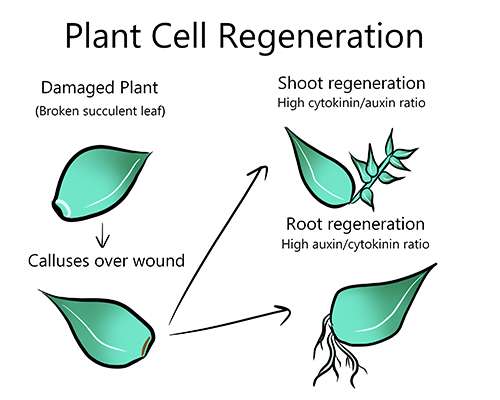 Plants are notoriously known for their medicinal properties that provide us with medication and treatments for diseases. Nevertheless, they are also living organisms that are susceptible to various diseases, infections, and injuries. The sessile nature of plants makes them vulnerable to a variety of injuries and infections which they deal with in different ways. As far as healing from physical injuries plants deal with this through a regenerative process. During this regeneration step, the plants use a protein called plethora to aid with the regeneration of damaged tissue. This coupled with the activation and expression of gene CUC2 allows plants to increase production of an essential growth hormone called Auxin. Auxin is a key developmental hormone that helps the plant to perform cell division and cell elongation to ensure that the plant heals from its wounds.
Plants are notoriously known for their medicinal properties that provide us with medication and treatments for diseases. Nevertheless, they are also living organisms that are susceptible to various diseases, infections, and injuries. The sessile nature of plants makes them vulnerable to a variety of injuries and infections which they deal with in different ways. As far as healing from physical injuries plants deal with this through a regenerative process. During this regeneration step, the plants use a protein called plethora to aid with the regeneration of damaged tissue. This coupled with the activation and expression of gene CUC2 allows plants to increase production of an essential growth hormone called Auxin. Auxin is a key developmental hormone that helps the plant to perform cell division and cell elongation to ensure that the plant heals from its wounds.
Researched by Georgina Vasquez, Biological Sciences (2023)
Please use this link to visit Georgina’s tree, the River Birch
How do plants respond to high-salt environments?
 In high-salt environments, the growth and development of plants can become reduced. In response to this stress signal, plants have evolved various mechanisms to cope with this type of environment. One way plants respond is by regulating ion homeostasis. This is done by a process that removes sodium from the cytoplasm. Plants can also respond by activating their osmotic stress pathway. With this, plants will send hormonal responses to certain areas of the plant. For example, this can help regulate the cell wall and strengthen the cytoskeleton of the plant’s cells.
In high-salt environments, the growth and development of plants can become reduced. In response to this stress signal, plants have evolved various mechanisms to cope with this type of environment. One way plants respond is by regulating ion homeostasis. This is done by a process that removes sodium from the cytoplasm. Plants can also respond by activating their osmotic stress pathway. With this, plants will send hormonal responses to certain areas of the plant. For example, this can help regulate the cell wall and strengthen the cytoskeleton of the plant’s cells.
Researched by Angelique Arnoldy, Biological Sciences (2023)
Please use this link to visit Angelique’s tree, the Northern Catalpa.
What types of bacterial diseases do plants encounter?
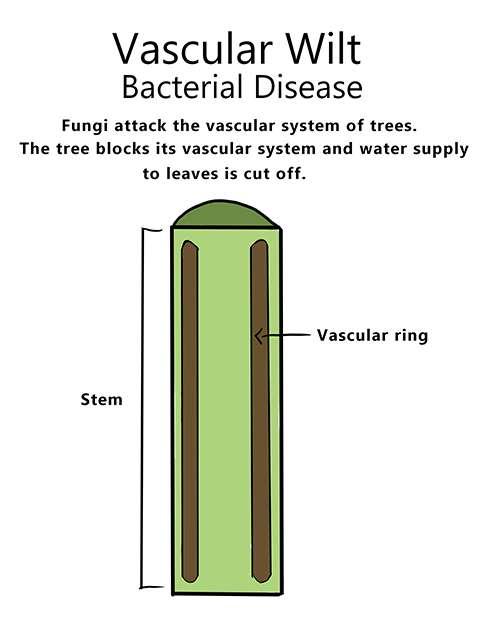 Bacteria are found all over, though they are microscopic and cannot be seen without a microscope. As bacteria make us sick, they also affect a plant’s health. Bacterial diseases in plants are grouped into four categories that are based on how the bacteria affects the plant’s tissue and signs that would occur from a bacterial disease infecting a plant. These bacterial disease categories include vascular wilt, necrosis, soft rot, and tumors. There are over 200 plant pathogenic bacterial species. Vascular wilt is caused by a fungal bacteria that will attack a plant’s vascular system, when this occurs the water supply to the leaves is cut off. Bacterial necrosis is the softening of plant tissues which will lead to the death of the plant’s cells as they are split open. Soft rot is a bacterial disease that is caused by gram-negative and gram-positive bacterias with the most common being Dickeyaand Pectobacterium. These pathogens will release enzymes that decompose the plant’s cell wall and plant tissues. Tumors seen in plants caused by bacteria are known as crown gall which is caused by the genetic change in a plant’s cells from the bacteria Agrobacterium tumefaciens. For all of these species, as they do differ they share a commonality in that they damage and destroy produce, trees, as well as other plants in forests, gardens, orchards.
Bacteria are found all over, though they are microscopic and cannot be seen without a microscope. As bacteria make us sick, they also affect a plant’s health. Bacterial diseases in plants are grouped into four categories that are based on how the bacteria affects the plant’s tissue and signs that would occur from a bacterial disease infecting a plant. These bacterial disease categories include vascular wilt, necrosis, soft rot, and tumors. There are over 200 plant pathogenic bacterial species. Vascular wilt is caused by a fungal bacteria that will attack a plant’s vascular system, when this occurs the water supply to the leaves is cut off. Bacterial necrosis is the softening of plant tissues which will lead to the death of the plant’s cells as they are split open. Soft rot is a bacterial disease that is caused by gram-negative and gram-positive bacterias with the most common being Dickeyaand Pectobacterium. These pathogens will release enzymes that decompose the plant’s cell wall and plant tissues. Tumors seen in plants caused by bacteria are known as crown gall which is caused by the genetic change in a plant’s cells from the bacteria Agrobacterium tumefaciens. For all of these species, as they do differ they share a commonality in that they damage and destroy produce, trees, as well as other plants in forests, gardens, orchards.
Researched by Cassandra Nowak, Biological Sciences (2023)
Please use this link to visit Cassandra’s tree, the Green Ash
What plants parasitize other plants?
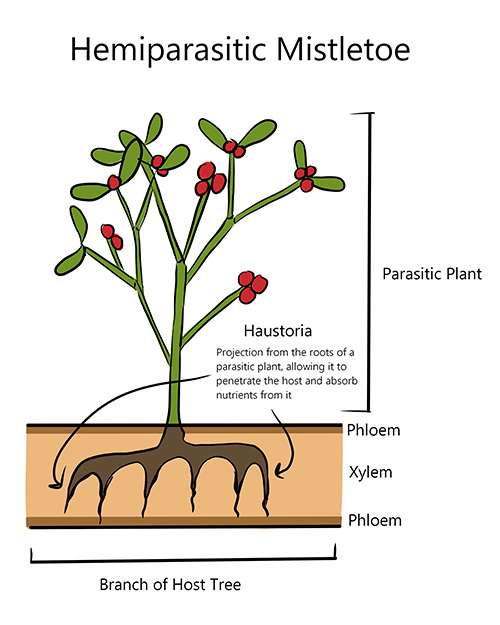 There are a few different kinds of parasitic plants. The first is known as hemiparasites. These plants rely on the host plant for water and nutrients but can perform photosynthesis on their own. Cuscuta, or dodder, are obligate hemiparasites. Obligate parasites die without the host, so they drain nutrients slowly. Some species of mistletoe are also parasitic! Holoparasites cannot photosynthesize, so they depend on the host plant for all of its nutrition and water. Monotropa uniflora, known as the ghost plant, is a holoparasite. The ghost plant lacks chlorophyll, the cell structure responsible for taking in sunlight, so it must drain its host plant of nutrients. The Indian paintbrush, Castilleja, is not an obligate parasite. This plant is able to survive on its own!
There are a few different kinds of parasitic plants. The first is known as hemiparasites. These plants rely on the host plant for water and nutrients but can perform photosynthesis on their own. Cuscuta, or dodder, are obligate hemiparasites. Obligate parasites die without the host, so they drain nutrients slowly. Some species of mistletoe are also parasitic! Holoparasites cannot photosynthesize, so they depend on the host plant for all of its nutrition and water. Monotropa uniflora, known as the ghost plant, is a holoparasite. The ghost plant lacks chlorophyll, the cell structure responsible for taking in sunlight, so it must drain its host plant of nutrients. The Indian paintbrush, Castilleja, is not an obligate parasite. This plant is able to survive on its own!
Researched by Lilliana De Salas, Biological Sciences (2023)
Please use this link to visit Lilliana’s tree, the Weeping Willow
What are the worst insect pests for trees?
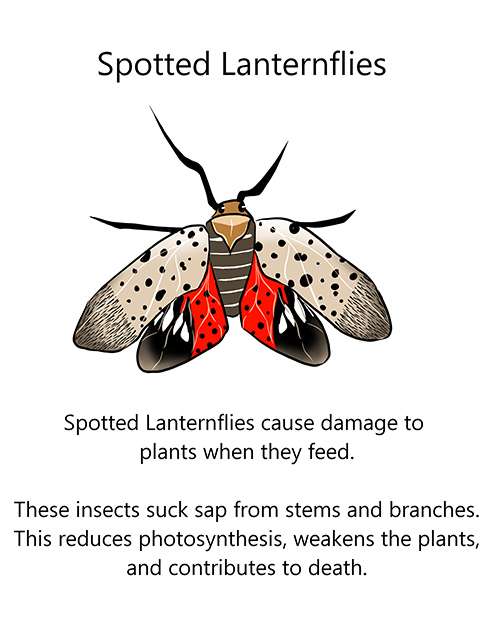 Insects can be very damaging to plants. There are three types of pest insects that can damage trees. They are burrowing insects, defoliating insects, and sucking insects. Burrowing insects are insects that will dig into the wood of the tree and live/feed under the bark. Insects that do this include, Asian longhorn beetles, Elm bark beetle, Emerald Ash Borer, Bronze Birch Borer, and the Dogwood Borer. This kind of insect can even go as far as killing the tree with its tactics. Defoliating insects eat through the leaves, which causes the tree to lose many of its leaves. This puts the tree in danger of dying or losing lots of nutrients as they cannot perform photosynthesis to feed themselves without many leaves. These types of insects include Japanese beetles, Tent caterpillars, Gypsy moths, Spring and fall cankerworms, Cherry fruit worms, Leafminers, and bagworms. Lastly, sucking insects feed off of the tree by inserting its mouth into the fruit or other parts of the plant and removing juices. While this occurs the insect can transmit disease to the trees, and also cause wilting of the trees. This again, is very harmful to the tree and can even lead to death. Different types of sucking insects include Aphids, Spider Mites, Thrips, Leafhoppers, and Scale Insects. With so many different insects being damaging to trees, it is important to know what may be causing this damage to the trees you see around you. Staying informed and learning about these insects will help us to be more aware of why we are seeing these patterns, and what to do afterwards.
Insects can be very damaging to plants. There are three types of pest insects that can damage trees. They are burrowing insects, defoliating insects, and sucking insects. Burrowing insects are insects that will dig into the wood of the tree and live/feed under the bark. Insects that do this include, Asian longhorn beetles, Elm bark beetle, Emerald Ash Borer, Bronze Birch Borer, and the Dogwood Borer. This kind of insect can even go as far as killing the tree with its tactics. Defoliating insects eat through the leaves, which causes the tree to lose many of its leaves. This puts the tree in danger of dying or losing lots of nutrients as they cannot perform photosynthesis to feed themselves without many leaves. These types of insects include Japanese beetles, Tent caterpillars, Gypsy moths, Spring and fall cankerworms, Cherry fruit worms, Leafminers, and bagworms. Lastly, sucking insects feed off of the tree by inserting its mouth into the fruit or other parts of the plant and removing juices. While this occurs the insect can transmit disease to the trees, and also cause wilting of the trees. This again, is very harmful to the tree and can even lead to death. Different types of sucking insects include Aphids, Spider Mites, Thrips, Leafhoppers, and Scale Insects. With so many different insects being damaging to trees, it is important to know what may be causing this damage to the trees you see around you. Staying informed and learning about these insects will help us to be more aware of why we are seeing these patterns, and what to do afterwards.
Researched by Sofia DiCastelnuovo, Biological Sciecnes (2023)
Please use this link to visit Sofia’s tree, the Japanese Zelkova
Learn more:
